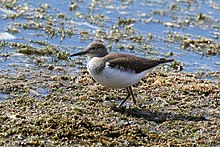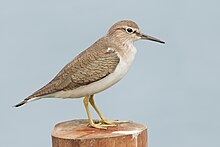Common sandpiper
| Common sandpiper | |
|---|---|
 |
|
| adult, Standlake, Oxfordshire | |
 |
|
| juvenile, Laem Pak Bia, Thailand |
|
| Scientific classification | |
| Kingdom: | Animalia |
| Phylum: | Chordata |
| Class: | Aves |
| Subclass: | Neornithes |
| Infraclass: | Neognathae |
| Superorder: | Neoaves |
| Order: | Charadriiformes |
| Suborder: | Scolopaci |
| Family: | Scolopacidae |
| Genus: | Actitis |
| Species: | A. hypoleucos |
| Binomial name | |
|
Actitis hypoleucos (Linnaeus, 1758) |
|
| Synonyms | |
Tringa hypoleucos Linnaeus, 1758
The common sandpiper (Actitis hypoleucos) is a small Palearctic wader. This bird and its American sister species, the spotted sandpiper (A. macularia), make up the genus Actitis. They are parapatric and replace each other geographically; stray birds of either species may settle down with breeders of the other and hybridize. Hybridization has also been reported between the common sandpiper and the green sandpiper, a basal species of the closely related shank genus Tringa.
The common sandpiper was one of the many bird species originally described by Linnaeus in the landmark 1758 10th edition of his Systema Naturae, where it was given the binomial name of Tringa hypoleucos. The current scientific name is from Ancient Greek. Actitis is from aktites, "coast-dweller" derived from akte, "coast", and hypoleucos is from hupo, "beneath", and leukos "white".
The adult is 18–20 cm (7.1–7.9 in) long with a 32–35 cm (13–14 in) wingspan. It has greyish-brown upperparts, white underparts, short dark-yellowish legs and feet, and a bill with a pale base and dark tip. In winter plumage, they are duller and have more conspicuous barring on the wings, though this is still only visible at close range. Juveniles are more heavily barred above and have buff edges to the wing feathers.
...
Wikipedia

